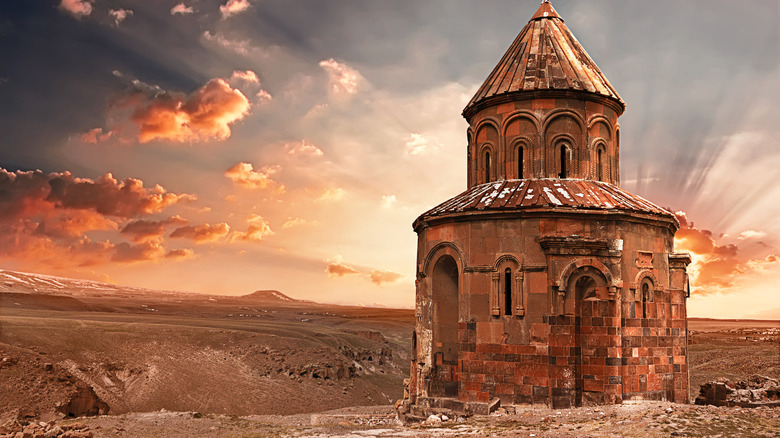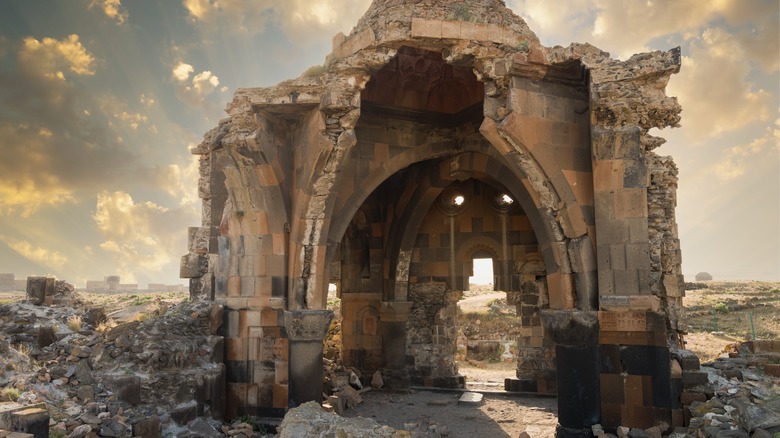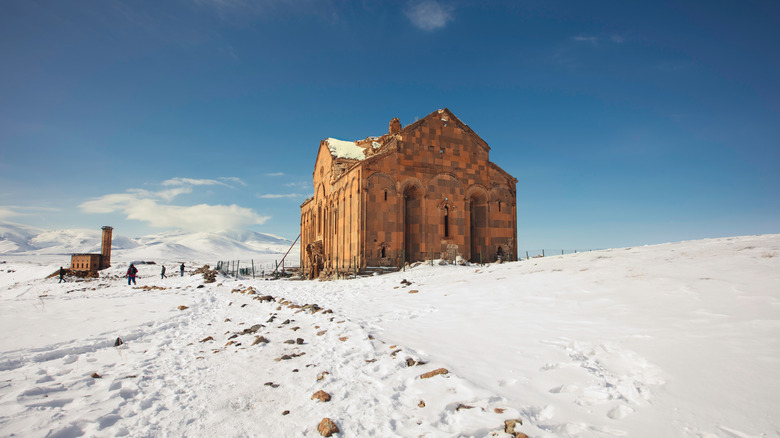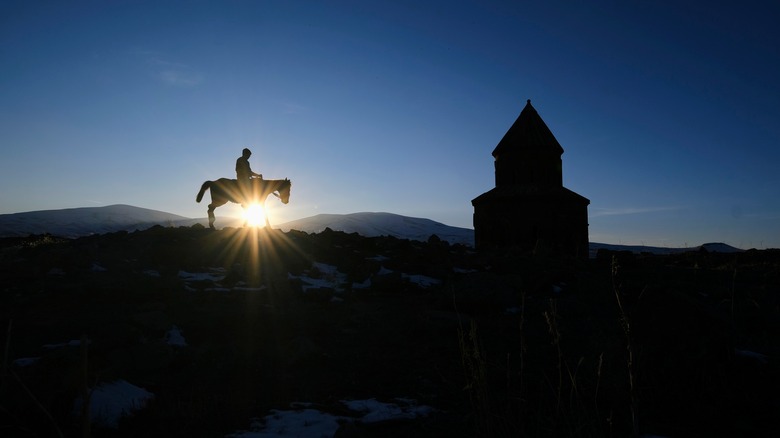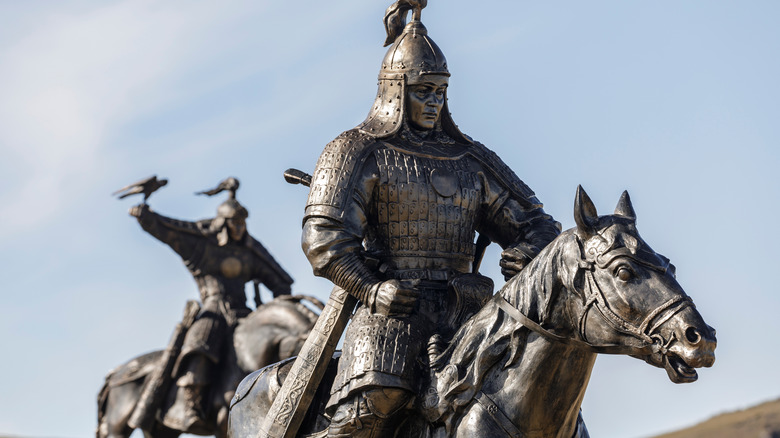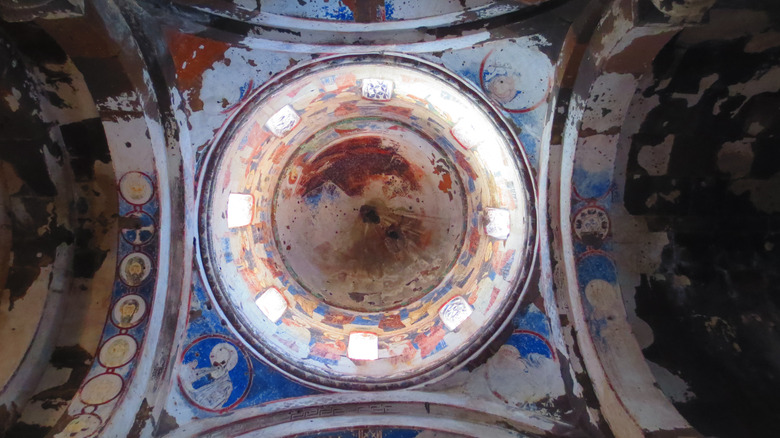The History Of Ani, The City Of A Thousand And One Churches
The ancient city of Ani isn't often listed as one of the world's natural wonders, but this grand Turkish site holds much fascination for lovers of archaeology and the history of the Middle Ages. The site has been called "the city of 1001 churches." Its dilapidated buildings stand within the dusty terrain along the Arpaçay River, east of the city Kar, and share a border with Armenia. The city is speculated to have housed over 100,000 occupants (per Britannica). Although that number can't be reliably determined, it is believable at first glance given the breadth of the medieval metropolis.
The city was in the hands of many rulers at one time, and it lived through the reigns of great empires — including the Byzantine and Georgian empires — before it ultimately collapsed. It still stands on a plateau in defensive isolation, seeing mainly tourists come through as they stare in wonder at the fading artistry of the Christian and Muslim ruins. Thus, after 90 years of abandonment, the city of Ani represents one of the world's most captivating ancient ghost towns (via BBC).
The City's Beginnings
Constructed in 3000 B.C., Ani was erected by Armenian leaders and merchants. It held a magnificent number of churches and other places of worship — although the number did not reach the count of its moniker. The actual number of religious structures uncovered by archaeologists is closer to 40, which includes mausoleums, chapels, and churches, as per BBC. Positioned ideally near the Silk Road, trade was plentiful during the city's height in the 10th and 11th centuries. During that time, it held a lofty status as the capital of the Armenian kingdom of the Bagratids (an ancient Christian dynasty from Georgia in the Middle Ages), as per UNESCO.
Little is known definitively about the origins of the city, however. The oldest description comes from the 5th or 6th century by an Armenian historian named Ghazar Parpetsi. He described Ani as a "hilltop fortress" built by the Kamskarakan house, otherwise called "one of the seven great houses of Iran," which were important aristocracies of great political influence (per Heritage Daily). The house ruled over the city until being forced to sell it to the Bagratids.
The Armenian Golden Age
Ani replaced the Bagratid capital of Katholikos in A.D. 961 — a shift in power that was overseen by King Ashot III. It was this event that brought the "Armenian Golden Age" to the chronicles of Middle Eastern history. The king's philanthropy resulted in the sponsorship of the large buildings that make up the city. The grand churches that were erected and adorned with the finest artwork of the period shed a positive light on the leader, earning Ashot the nickname "The Merciful" (via Heritage Daily).
But archaeologists say there were more than churches in Ani since the city was a highly populated urban area. Artistic reconstructions of the site show myriad artisanal workshops and homes in addition to the religious structures that capture the public's attention. One building of particular grandeur is the Cathedral of Ani. Built in the 11th century under the reign of King Gagik, the maroon remains loom high over the now barren land and trigger imaginings of the ceremonies that must have been integral to their religious life (via BBC).
The Battle with the Byzantine Empire
In 1042, Ani went to war with the Byzantine Empire. Known as the Battle of Ani, the war took place while Ani was under the rule of Vahram Pahlavouni. The emperor of Byzantine had his sights on Ani and plotted a takeover to make the territory a part of the empire. He started his plan by endorsing an Armenian rebel who supported the Byzantines, and once in power, the rebel handed Ani over to the Byzantines. The Armenians resisted, however, and backed Pahlavouni, who gathered a strong army of approximately 50,000 men (via "History of Armenia"). Ultimately, the Byzantines lost the war after accruing numerous casualties. Given the amount of bloodshed, legend states that the blood from the many wounded made the Akhurian River crimson.
Despite Ani's victory, their sovereignty was secured for only a few more years. Pahlavouni, though victorious after his defeat of the Seljuk Turks, would see the occupation of the Byzantines in 1045. A year later, Pahlavouni died, and Ani surrendered, resulting in a Byzantine emperor holding power over the city (via VirtualANI).
The History of Ani's Decline
After the Byzantines took control, Ani went through more conquests, including the Seljuk Turks in 1071 and the Georgians in 1200 (per VirtualANI). In the 13th century, an invasion occurred that, along with a natural disaster, began Ani's decline. The reign of the Mongol Empire gripped the world over the 13th and 14th centuries, resulting in the acquisition of territories from the Sea of Japan to the Levant (via Britannica). In 1237, the Mongols invaded Ani, and by the late 14th century, the conqueror Tamerlane had captured the city. But by then, the city was already on the verge of collapse.
In 1319, an earthquake struck the city, damaging some of the majestic structures. This occurred in the midst of mass emigrations, which had started when the Mongols first invaded. In the 16th century, the ownership of Ani changed hands again when the Ottoman Empire achieved conquest over the land. By the 1700s, people in the rural regions around the city deserted Ani in response to attacks from Kurdish tribes, as per VirtualANI. This ultimately led to the total abandonment of the city, after which it was vandalized by looters (per History Daily).
Modern Conservation and Tourism
By the 19th century, European travel to Armenia increased, and explorers documented or made mention of the site of Ani. In the same century, the territory became part of the Russian Empire following their war against Turkey. At the turn of the century, Russian archaeologists began excavations, discovering the walls of King Ashot and an array of impressive frescoes (per VirtualANI). Although there was a renewed interest in the site, it was closed down by the time of World War I. Since then, poor attempts have been made to restore the ruined buildings, with mismatched bricks being used for the Merchant's Palace (via The Atlantic). Further conservation efforts took place in 2007-2009 as preservationists worked to retain the integrity of the Ebul Menuçher Mosque (via Hurriyet Daily News).
In 2004, the Turkish Ministry of Culture had taken over the site, and, as a result, it became possible for people to travel there without a permit (via VirtualANI). Today, Ani has come out of its former solitude, seeing many tourists come through from all over the world, with over 20,000 touring in 2011 alone (via Hurriyet Daily News). As cultural officials in Turkey have said, the site is particularly appealing for its representation of various world religions. And one can't deny that it also speaks to a universal desire to get a deeper look at the ancient past.
